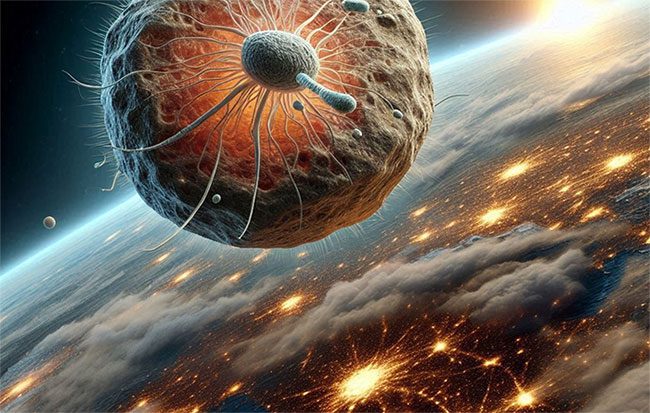The organism that scientists refer to as the “last universal common ancestor of the universe” lived 4.2 billion years ago.
According to Sci-News, a group of scientists from the University of Bristol (UK) has successfully sought out the “last universal common ancestor” (LUCA), a hypothetical ancestor of all life on Earth and possibly many other planets.
LUCA is the top node of the Earth’s ecosystem, from which the original life forms, including bacteria and archaea, diverged.

A strange, more complex seed of life than we imagined arrived on Earth and became the common ancestor of all species? – (AI Image: ANH THƯ).
As widely accepted theories about the origin of life on Earth suggest, after our planet formed, the first seeds of life “traveled” from space via meteorites and comets.
Over billions of years, those seeds of life evolved into the entire world of organisms we see today.
What did that first seed of life look like? Was it a living organism or merely primordial prebiotic materials? LUCA may very well be that seed of life.
In their new study, scientist Edmund Moody from the University of Bristol and his colleagues compared all the genes in the genomes of living species, counting the mutations that occurred in their sequences over time.
The divergence times of certain species are known from the fossil record, allowing researchers to use a genetic equation analogous to the familiar equations used in physics to calculate rates to determine when LUCA existed.
The results indicate that LUCA lived approximately 4.2 billion years ago, which is 400 million years after Earth formed.
Dr. Sandra Álvarez-Carretero, a co-author, noted that they did not expect this common ancestor to be so ancient.
However, this finding aligns with modern views on the potential for life to exist on early Earth.
Previously, it was believed that until the end of the Hadean Eon, around 3.8 billion years ago, Earth was still a fiery ball, and life only began to take root afterward.
However, some recent evidence from Australia indicates signs of organic material that likely originated from microorganisms, “sealed” within rocks dating back 3.8 to 4.1 billion years.
The research process by the Bristol team also revealed that LUCA was a complex organism, not vastly different from modern prokaryotic life, but what is truly intriguing is that it evidently possessed an early immune system.
LUCA manipulated and altered its living environment but was incapable of living in isolation. It depended on the very organisms that arose from it. Its waste would also serve as food for other bacteria, helping to create a recycling ecosystem.
According to Professor Philip Donoghue, a co-author, LUCA demonstrates how quickly ecosystems can form on early Earth.
This also suggests that life could thrive in Earth-like biospheres elsewhere in the vast universe.
The study has just been published in the scientific journal Nature Ecology & Evolution.





















































